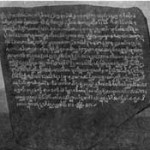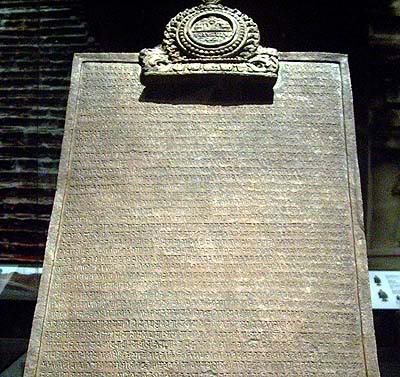
When considering Muarajambi region, one must take into account the history of Srivijaya and its historical remains. The physical evidences mainly consist of the complex, various artifacts and statues as well as epigraphical evidences in the form of inscriptions.
Archaelogical Evidences
The main archaeological evidence is obviously the Muarajambi complex with scattered temple buildings, “menapos” (mound of ruins) and other remains such as statues and other artifacts. Relevant complex include the ones around Jambi and Batanghari river, Palembang and Musi river, Siguntang hill and the remains found in various other places.
Epigraphical Evidences

Evidences in the form of inscriptions related to Muarajambi region, include:
• Inscription of Kedukan Bukit (683 CE)
• Inscription of Talang Tuwo (684 CE)
• Few “Curse” inscriptions such as Kota Kapur (686 CE), Sabokingking, Karang Brahi and Palas Pasemah.
A detailed review on these inscriptions will be discussed in other articles.
Nalanda Copperplate (860 CE)
The Nalanda Copperplate was issued by a king of Bengal named Devapaladeva. Written in Devanagari and proto-Bengali, the script constitutes a request from a king of Suvarnadvipa named Balaputradeva to build a monastery in Nalanda, where king Devapaladeva offered five villages to maintain the monastery and support the students.
From the copperplate it is evident that at the time there existed very close and reciprocal relationships in the fields of religion, politics, trades and education between the kings of India and Srivijaya. The nature of the relationship is also apparent as we compare Nalanda University and Muarajambi.
The Larger and Smaller Leiden Grants (1015 CE)
The Larger and Smaller Leiden Grants inscriptions tell of a king of Suvarnadvipa, Sri Maravijayatunggavarman built a monastery at Nagapattana in South India in the name of his father Cudamanivarman. The Chola king Rajaraja, in about 1005 CE granted a village for the upkeep of this monastery. This indicates the relationship between Indonesia (Srivijaya) and India was preserved for many generations.
The Nalanda Copperplate was issued by a king of Bengal named Devapaladeva. Written in Devanagari and proto-Bengali, the script constitutes a request from a king of Suvarnadvipa named Balaputradeva to build a monastery in Nalanda, where king Devapaladeva offered five villages to maintain the monastery and support the students.
From the copperplate it is evident that at the time there existed very close and reciprocal relationships in the fields of religion, politics, trades and education between the kings of India and Srivijaya. The nature of the relationship is also apparent as we compare Nalanda University and Muaro Jambi.
 Bahasa
Bahasa
 October 24th, 2010
October 24th, 2010  SUDIMUJA
SUDIMUJA 
 Posted in
Posted in  Tags:
Tags: